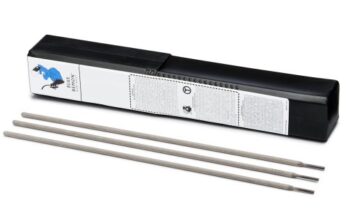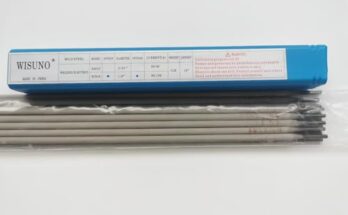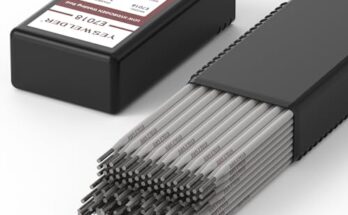Need to tackle a tough welding job? Understanding the right tools is crucial. This article dives into the world of p5 welding rod, explaining its properties, applications, and how it compares to other options. Let’s get started!
P5 welding rods are a type of electrode used in
shielded metal arc welding (SMAW), often referred to as stick welding. They’re known for their versatility and ability to create strong, reliable welds in various metals. The “P” typically designates a low-hydrogen electrode, meaning it contains minimal moisture, crucial for preventing hydrogen embrittlement—a weakening of the weld that can lead to cracking. The “5” usually denotes a specific tensile strength or other metallurgical characteristic dictated by the manufacturer’s specifications. It’s important to always refer to the manufacturer’s data sheet for precise details as the numbering system can vary slightly between brands.
For example, a Lincoln Electric P5 electrode might have slightly different properties compared to a Miller P5 electrode, even if both are marketed as “P5.” These differences are usually minor and fall within acceptable ranges for the intended application. Always prioritize checking the manufacturer’s specifications before starting any welding project. This careful attention to detail is essential for ensuring the safety and quality of your work. Consider it akin to selecting the right type of screw for a particular job – using the wrong one could lead to structural compromise.
The low-hydrogen characteristic is especially vital in situations requiring high-strength welds or where cracking is a concern. Think critical welds in pipelines, pressure vessels, or structural steel. The low-hydrogen content reduces the risk of these problems significantly, leading to a more robust and reliable weld. This makes P5 rods a popular choice for a wide range of professional welding applications. Understanding these nuances allows you to choose the right tool for the task and perform the job effectively and safely.
Key Features and Properties of P5 Welding Rods
P5 welding rods are designed with specific features that contribute to their effectiveness. These features often include:
- Low Hydrogen Content: This minimizes the risk of hydrogen embrittlement and subsequent cracking in the weld.
- High Tensile Strength: P5 rods generally produce welds with excellent tensile strength, making them suitable for high-stress applications.
- Good Weldability: They typically offer good arc stability and penetration, leading to consistent and smooth welds.
- Versatile Application: They are often used on various metals, including mild steel, low-alloy steel, and even some high-strength steels. However, always check the manufacturer’s specifications to confirm compatibility with your chosen material.
- Smooth Arc: This facilitates a clean and efficient welding process, reducing spatter and improving the overall quality of the weld. A smooth arc makes the welding process more manageable, especially for those with less experience.
Think of these properties as contributing to the overall performance of the weld – much like choosing components for a high-performance computer. A fast processor (high tensile strength) combined with reliable RAM (good weldability) leads to optimal results.
P5 Welding Rod vs. Other Electrodes: A Comparative Analysis
Comparing P5 to Other Low-Hydrogen Electrodes
While P5 rods are categorized as low-hydrogen, they’re not the only ones available. Different numbers (e.g., P6, P7) often denote variations in tensile strength, chemical composition, or other properties. Higher numbers might indicate higher tensile strength but sometimes come with trade-offs in weldability or other characteristics. For instance, a P7 electrode might offer even greater strength but require more precise welding technique.
Choosing between different low-hydrogen electrodes depends heavily on the specific application. Factors like the base metal, required tensile strength, and welding position play a crucial role. A structural steel application needing extreme strength might warrant a higher-numbered electrode, whereas general fabrication work might be perfectly served by a P5. Consulting welding codes and standards specific to your project is highly recommended for making the right selection.
The selection process is similar to choosing the right type of paint for a project – you wouldn’t use exterior paint for interior walls, nor would you use house paint for a car. Similarly, the properties of different low-hydrogen electrodes must be carefully considered based on their application.
P5 Rods and Their Suitability for Different Metals
While P5 rods excel with mild steel and low-alloy steels, their applicability to other metals is limited. Attempting to weld dissimilar metals with a P5 electrode without proper pre-qualification could result in poor weld quality, cracking, or other issues. Each metal has its own unique welding requirements, and using the incorrect electrode can significantly compromise the weld’s integrity.
For instance, welding aluminum or stainless steel would require electrodes specifically designed for those metals. Using a P5 on aluminum would likely produce a weak and brittle weld prone to failure. This highlights the importance of understanding the compatibility of electrodes with the base materials before starting any welding work.
Think of it as trying to use a screwdriver to hammer in a nail; the result would be inefficient and potentially damaging. Similarly, using the wrong electrode for the wrong metal will lead to suboptimal results, potentially dangerous in structural or high-consequence applications.
Applications of P5 Welding Rods in Various Industries
P5 Rods in Construction and Fabrication
In the construction and fabrication industries, P5 welding rods find extensive use in creating strong and reliable welds for various structural components. From building frameworks to assembling machinery, their high tensile strength and low-hydrogen properties make them a dependable choice. The consistency of the welds is paramount in these industries, ensuring structural integrity and longevity of the structures.
The smooth arc characteristic of P5 electrodes also makes welding easier and faster. This translates to increased productivity on construction sites and in fabrication shops. The reduced spatter also means less cleaning and rework, adding to the overall efficiency of the process.
Imagine building a skyscraper; the strength and reliability of the welds are critical. P5 rods provide the necessary properties to ensure the structural integrity of such a project, underscoring their importance in large-scale construction.
P5 Welding Rods in Automotive and Transportation
The automotive and transportation industries benefit greatly from the high-strength and consistent welds provided by P5 rods. In car manufacturing, they are often employed in welding chassis components, body panels, and other structural elements. Similar applications exist in the manufacturing of trucks, trains, and other modes of transportation.
The low-hydrogen content is crucial here, preventing potential cracks that could compromise the structural integrity of vehicles and endanger passengers. The high tensile strength ensures that welds can withstand the stresses experienced during operation and impact events. This reliable performance is crucial for safety and longevity.
Think about the rigorous testing that vehicles must undergo—P5 welding rods contribute to the durability and safety of vehicles by ensuring strong, dependable welds that withstand stress.
Safety Precautions and Best Practices When Using P5 Welding Rods
Essential Safety Equipment and Procedures
Welding with P5 rods, or any electrode, necessitates the use of appropriate safety equipment. This includes a welding helmet with proper shade lenses to protect your eyes from harmful UV radiation, welding gloves to protect your hands from burns and sparks, and appropriate clothing to prevent burns and protect your skin. Proper ventilation is also critical to minimize exposure to harmful fumes.
Beyond personal protective equipment (PPE), following proper welding procedures is just as crucial. This involves ensuring proper grounding, using the correct amperage settings for the electrode and base metal, and maintaining a clean welding area. These practices minimize the risk of electric shock, burns, and other hazards associated with welding.
Welding is inherently dangerous; neglecting safety protocols can lead to serious injury. Treat every welding job with the utmost caution and respect for the inherent risks involved. Your safety is paramount.
Proper Electrode Storage and Handling
P5 electrodes, being low-hydrogen, are sensitive to moisture. Improper storage can introduce moisture into the electrode, compromising its performance and potentially leading to weld cracking. Electrodes should be stored in a dry, sealed container, preferably heated to reduce moisture absorption. Once opened, the electrodes should be used promptly to minimize moisture exposure.
Handling the electrodes correctly is also essential. Avoid touching the electrode coating as this can contaminate the weld. Always ensure the electrode is clean and free from any debris before starting the welding process. These steps contribute to the overall quality and safety of the weld.
Maintaining the proper storage and handling procedures is similar to storing sensitive electronics – exposure to humidity can cause damage and compromise performance. The same principle applies to low-hydrogen electrodes like P5.
Factors Affecting P5 Welding Rod Performance
The Role of Amperage and Arc Length
The amperage setting significantly impacts the performance of P5 welding rods. Using too low of an amperage can lead to poor penetration and an uneven weld. Conversely, using too high of an amperage can cause excessive spatter, burn-through, and a weak weld. The correct amperage will be specified by the manufacturer for the specific electrode and base metal combination. It is vital to follow these guidelines closely.
Arc length also plays a critical role in the weld quality. Too short of an arc can lead to sticking and excessive spatter. Too long of an arc will result in poor penetration and an unstable arc. Maintaining the optimal arc length is essential for achieving a smooth, consistent weld. Proper technique and experience contribute to maintaining the optimal arc length throughout the welding process.
Finding the right balance between amperage and arc length is essential, similar to tuning an engine – getting it right leads to optimal performance, while getting it wrong can lead to problems.
Base Metal Preparation and its Influence
Proper preparation of the base metal is just as critical as selecting the right electrode and parameters. The base metal must be clean, free of rust, paint, oil, or other contaminants. These contaminants can affect the weld’s quality and strength. Cleaning the metal often involves grinding, brushing, or other methods depending on the material and the level of contamination.
The base metal’s surface should also be properly prepared to ensure good penetration. This might involve beveling edges to allow for proper fusion of the base metal and the weld. Proper surface preparation is key to achieving a strong and reliable weld that meets the required specifications.
Ignoring proper base metal preparation is like trying to build a house on a cracked foundation; the result will be unstable and potentially unsafe. Proper preparation ensures a stable and reliable weld.
Choosing the Right P5 Welding Rod for Your Project
Understanding Manufacturer Specifications
Before purchasing any P5 welding rod, it’s crucial to carefully review the manufacturer’s specifications. These specifications provide vital information about the electrode’s properties, including its chemical composition, tensile strength, recommended amperage range, and suitable base metals. This information is essential for ensuring that the electrode is appropriate for your specific application.
Always prioritize reputable manufacturers known for their quality control and adherence to industry standards. Checking independent reviews and certifications can help you choose a high-quality product that meets your requirements and ensures a safe and effective welding process.
Choosing the right welding rod is like choosing the right tool for a job; the wrong choice can lead to frustration, inefficiency, or even damage. Carefully reviewing the manufacturer’s specifications helps ensure the right choice.
Factors to Consider When Making Your Selection
Several factors influence the choice of P5 welding rod. The base metal being welded, the required tensile strength of the weld, the welding position (flat, vertical, overhead), and the availability of specific electrode types all play a significant role in the selection process. Understanding these factors helps you make an informed decision that ensures the success of your welding project.
Additionally, consider the cost and availability of the electrodes. While price shouldn’t be the sole determining factor, finding a balance between quality, performance, and cost is important. Choosing the wrong electrode can be far more expensive in the long run due to rework, repairs, or material wastage. Prioritize quality, but balance that with cost-effectiveness for optimal results.
Selecting a welding rod involves careful consideration of various factors, much like choosing the right car for your needs – some factors prioritize performance, while others might prioritize fuel efficiency and cost. Consider all elements to achieve the best outcome.
Frequently Asked Questions
What is p5 welding rod best for?
P5 welding rods are best suited for welding mild steel and low-alloy steels in various applications where high tensile strength and resistance to cracking are crucial. They’re excellent for structural work, fabrication, and applications requiring durable, reliable welds. However, always consult the manufacturer’s specifications to ensure compatibility with your specific base material.
What are the benefits of using a P5 welding rod?
P5 rods offer several key advantages: low hydrogen content minimizes the risk of weld cracking (hydrogen embrittlement), high tensile strength ensures durable welds capable of withstanding significant stress, and generally good weldability with a smooth arc for efficient welding. Their versatility makes them suitable for various applications.
How do I choose the correct amperage for a P5 welding rod?
The optimal amperage depends on the specific P5 electrode and the base metal being welded. Always refer to the manufacturer’s specifications for recommended amperage ranges. Using the wrong amperage can result in poor penetration, excessive spatter, or a weak weld. Learn more about adjusting amperage based on material thickness and electrode diameter.
What safety precautions should I take when using P5 welding rods?
Always wear appropriate personal protective equipment (PPE), including a welding helmet with the correct shade, welding gloves, and protective clothing. Ensure proper ventilation to minimize exposure to fumes. Proper grounding and correct welding techniques are vital to avoid electric shock, burns, and other potential hazards. Learn more about comprehensive welding safety procedures.
How should I store P5 welding rods to maintain their quality?
Store P5 electrodes in a dry, sealed container, ideally in a heated environment to minimize moisture absorption. Low-hydrogen electrodes are sensitive to moisture, and improper storage can compromise their performance. Use opened electrodes promptly to minimize the risk of moisture contamination. Learn more about proper electrode storage practices.
What are the differences between P5, P6, and P7 welding rods?
The numbers (5, 6, 7) often indicate variations in tensile strength and other metallurgical properties. Higher numbers typically signify higher tensile strength, but they might also have trade-offs in terms of weldability or other characteristics. The specific differences vary between manufacturers, so always check the individual product specifications.
Can I use a P5 welding rod on all types of metal?
No, P5 rods are primarily designed for mild steel and low-alloy steels. Using them on other metals like aluminum or stainless steel will likely result in poor weld quality and could be dangerous. Always use electrodes specifically designed for the metal you are welding to ensure optimal results and safety.
Final Thoughts
Selecting the right welding rod for your project is crucial for achieving high-quality, safe, and durable welds. P5 welding rods, with their low-hydrogen properties and high tensile strength, are a versatile and popular choice for many applications. However, understanding their characteristics, limitations, and proper usage is vital. Remember to always consult the manufacturer’s specifications, prioritize safety precautions, and practice proper welding techniques to ensure the success of your project and your personal safety. With careful consideration and attention to detail, you can confidently use P5 welding rods to create strong and reliable welds for years to come. Now go out there and build something amazing!


